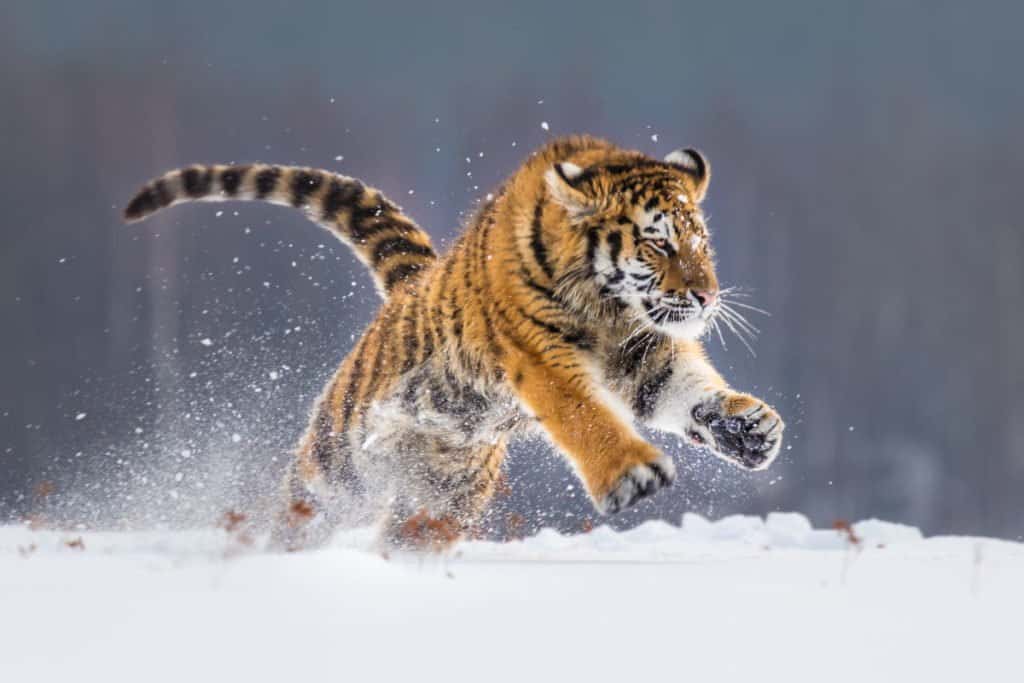10 Incredible Siberian Tiger Facts
Siberian tigers, or Amur tigers, are the largest of all the subspecies of tigers found around the globe. As one of the largest carnivorous land mammals, the Siberian tiger lives in mountainous regions of the Russian Far East, as well as some areas of China. This type of tiger is remarkable, but it is also endangered.
Here are 10 incredible Siberian tiger facts that everyone should know!
1. Siberian Tigers Are The Only Tigers That Live And Survive In The Snow

Jan Stria/Shutterstock.com
Siberian tigers are the only tiger species that live in incredibly harsh and snowy conditions, so they are quite unique in that way. They achieve this thanks to their thick and luscious coats. It remains long throughout the extremely cold winter months. In addition, the tuft of fur around their necks acts as a scarf to keep them warm. Siberian tigers also have a layer of insulating fat around their belly that contributes to conserving heat along with heavily furred paws that act as a sort of furry boots.
2. Siberian Tigers Are Huge
Siberian tigers are the largest species of tiger in the world, with adults weighing an average of over 600 pounds. Male Siberian tigers can reach lengths of up to 11 feet long. Their diet can make them weigh as much as 900 pounds. Female Siberian tigers happen to be a little smaller, coming in at about 9 feet long and weighing anywhere from 350 to 400 pounds. In cold environments, their large size serves them well since a larger animal will conserve heat much better than a smaller one.
3. The Siberian Tiger Is Endangered
Sadly, only 400 Siberian Tigers remain in the wild. The majority of that population resides in the Far East of Russia and affects the ecosystem there in a big way. This extraordinary creature is heavily hunted, which is one of the reasons why they are endangered. Their fur is sold throughout black market fur trades, and some people even consider Siberian cat meat to be a delicacy. In recent years, captive breeding of tigers in China has increased to the point where more than 4,000 tigers have been raised. According to the World Wildlife Fund, China has the world’s second-largest captive tiger population, after the U.S., which had an estimated 4,692 captive tigers back in 2005.
4. Siberian Tigers Have Huge Appetites
Siberian tigers are quite large, so it isn’t surprising that they eat so much. In one sitting, a Siberian tiger can eat 20 to 60 pounds of meat, depending on how hungry it is. Most Siberian tigers are not successful on hunts, and it requires a lot of patience and stalking to catch their prey. Their diet consists of animals such as water buffalos, boars, deers, and elk.
5. Siberian Tigers Are Solitary Creatures

iStock.com/Kathrine Andi
What many people may not know is that Siberian tigers are incredibly solitary animals. They are extremely territorial and do not like to be around other tigers. Their territories are marked by spraying, and some of their territories can cover hundreds of square miles. The only exception to this is female tigers who are feeding their young. However, once the cubs reach adulthood, they will eventually go off on their own. In order to mate, females will use a variety of sounds and meows to let the males know they are ready. These vocalizations allow both male and female Siberian tigers to communicate with each other and state their intentions while still remaining solitary beings.
6. Siberian Tigers Have Their Own Unique Stripes
Similar to human fingerprints, no two Siberian tigers have the same striped pattern on their fur. This means that individually each tiger has its own unique pattern that makes it easier to distinguish from others. During the winter, their fur becomes lighter, and in addition to keeping the animal warm, it also serves to camouflage them when hunting. The winter coat usually has a more muted shade of color than the summer coat. Winter fur has a longer length as well, so the stripes appear wider with less defined outlines.
7. Siberian Tigers Can Live Up To 25 Years In Captivity
The Siberian Tiger lives an average of 16 to 18 years, similar to other tigers. In addition, it may be shortened due to poaching and hunting. In captivity, some Siberian tigers can live over 20 years! Siberian tigers in captivity are meant to restore and preserve the small number of tigers left in the world and hopefully protect them from becoming extinct.
8. The Gestation Period In Siberian Tigers is about 3-4 Months
Female Siberian tigers have a gestation period of about 100 days or so and only give birth once every two years. In a Siberian tiger litter, there can be anywhere from 2 to 6 cubs. It is incredibly crucial that the mother catch enough food for the cubs or they might not survive. The cubs will remain with their mother for about 2-3 years before leaving to begin their own lives.
9. Siberian Tigers Have Incredible Night Vision

Since they usually hunt at night, Siberian tigers have incredible night vision, allowing them to stalk and wait for prey. Their night vision is said to be six times better than that of humans. Their forward-facing eyes have binocular vision as well. Siberian tigers can perceive a three-dimensional image of their surrounding, which aids them in hunting.
10. Siberian Tigers Can Run At 60 Miles Per Hour
Considering how large the Siberian tiger is, it’s an incredible feat for it to run at such high speeds. Siberian Tigers can reach up to 60 mph on average, but it is incredibly difficult for them to maintain this speed. As a result, they rely more heavily on their eyesight and stalking skills when hunting at night to avoid having to use their speed.
More from A-Z Animals
Siberian tigers, or Amur tigers, are the largest of all the subspecies of tigers found around the globe. As one of the largest carnivorous land mammals, the Siberian tiger lives in mountainous regions of the Russian Far East, as well as some areas of China. This type of tiger is remarkable, but it is also endangered.
Here are 10 incredible Siberian tiger facts that everyone should know!
1. Siberian Tigers Are The Only Tigers That Live And Survive In The Snow

Jan Stria/Shutterstock.com
Siberian tigers are the only tiger species that live in incredibly harsh and snowy conditions, so they are quite unique in that way. They achieve this thanks to their thick and luscious coats. It remains long throughout the extremely cold winter months. In addition, the tuft of fur around their necks acts as a scarf to keep them warm. Siberian tigers also have a layer of insulating fat around their belly that contributes to conserving heat along with heavily furred paws that act as a sort of furry boots.
2. Siberian Tigers Are Huge
Siberian tigers are the largest species of tiger in the world, with adults weighing an average of over 600 pounds. Male Siberian tigers can reach lengths of up to 11 feet long. Their diet can make them weigh as much as 900 pounds. Female Siberian tigers happen to be a little smaller, coming in at about 9 feet long and weighing anywhere from 350 to 400 pounds. In cold environments, their large size serves them well since a larger animal will conserve heat much better than a smaller one.
3. The Siberian Tiger Is Endangered
Sadly, only 400 Siberian Tigers remain in the wild. The majority of that population resides in the Far East of Russia and affects the ecosystem there in a big way. This extraordinary creature is heavily hunted, which is one of the reasons why they are endangered. Their fur is sold throughout black market fur trades, and some people even consider Siberian cat meat to be a delicacy. In recent years, captive breeding of tigers in China has increased to the point where more than 4,000 tigers have been raised. According to the World Wildlife Fund, China has the world’s second-largest captive tiger population, after the U.S., which had an estimated 4,692 captive tigers back in 2005.
4. Siberian Tigers Have Huge Appetites
Siberian tigers are quite large, so it isn’t surprising that they eat so much. In one sitting, a Siberian tiger can eat 20 to 60 pounds of meat, depending on how hungry it is. Most Siberian tigers are not successful on hunts, and it requires a lot of patience and stalking to catch their prey. Their diet consists of animals such as water buffalos, boars, deers, and elk.
5. Siberian Tigers Are Solitary Creatures

iStock.com/Kathrine Andi
What many people may not know is that Siberian tigers are incredibly solitary animals. They are extremely territorial and do not like to be around other tigers. Their territories are marked by spraying, and some of their territories can cover hundreds of square miles. The only exception to this is female tigers who are feeding their young. However, once the cubs reach adulthood, they will eventually go off on their own. In order to mate, females will use a variety of sounds and meows to let the males know they are ready. These vocalizations allow both male and female Siberian tigers to communicate with each other and state their intentions while still remaining solitary beings.
6. Siberian Tigers Have Their Own Unique Stripes
Similar to human fingerprints, no two Siberian tigers have the same striped pattern on their fur. This means that individually each tiger has its own unique pattern that makes it easier to distinguish from others. During the winter, their fur becomes lighter, and in addition to keeping the animal warm, it also serves to camouflage them when hunting. The winter coat usually has a more muted shade of color than the summer coat. Winter fur has a longer length as well, so the stripes appear wider with less defined outlines.
7. Siberian Tigers Can Live Up To 25 Years In Captivity
The Siberian Tiger lives an average of 16 to 18 years, similar to other tigers. In addition, it may be shortened due to poaching and hunting. In captivity, some Siberian tigers can live over 20 years! Siberian tigers in captivity are meant to restore and preserve the small number of tigers left in the world and hopefully protect them from becoming extinct.
8. The Gestation Period In Siberian Tigers is about 3-4 Months
Female Siberian tigers have a gestation period of about 100 days or so and only give birth once every two years. In a Siberian tiger litter, there can be anywhere from 2 to 6 cubs. It is incredibly crucial that the mother catch enough food for the cubs or they might not survive. The cubs will remain with their mother for about 2-3 years before leaving to begin their own lives.
9. Siberian Tigers Have Incredible Night Vision

Since they usually hunt at night, Siberian tigers have incredible night vision, allowing them to stalk and wait for prey. Their night vision is said to be six times better than that of humans. Their forward-facing eyes have binocular vision as well. Siberian tigers can perceive a three-dimensional image of their surrounding, which aids them in hunting.
10. Siberian Tigers Can Run At 60 Miles Per Hour
Considering how large the Siberian tiger is, it’s an incredible feat for it to run at such high speeds. Siberian Tigers can reach up to 60 mph on average, but it is incredibly difficult for them to maintain this speed. As a result, they rely more heavily on their eyesight and stalking skills when hunting at night to avoid having to use their speed.





